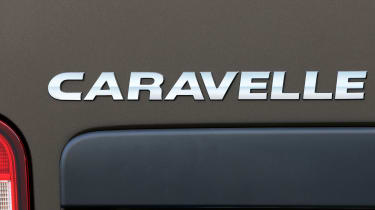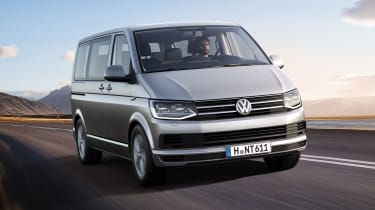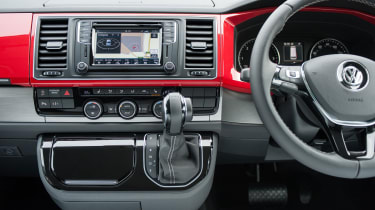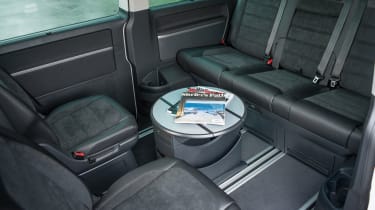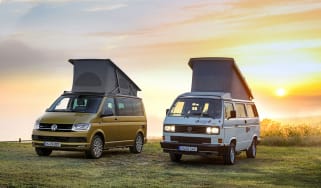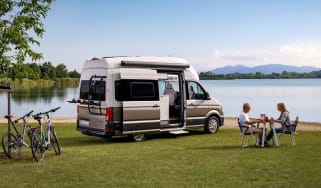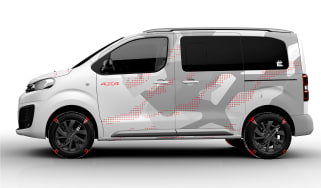Volkswagen Caravelle MPV (2015-2021)
"The VW Caravelle's boxy van-like looks bring van-like practicality thanks to a hugely spacious cabin"
Pros
- Diesels offer impressive economy
- Good-quality interior
- Spacious cabin
Cons
- Boxy shape
- Ride is uncomfortable
- Cheaper alternatives available
Volkswagen has been synonymous with van production since the 1950s. During the Sixties, certain VW vans found favour with the ‘peace and love’ movement, and that association has helped create a remarkable following for them ever since.
Today’s Volkswagen van is a very different beast. The rugged simplicity of the original ‘Type 2’ van has given way to the upmarket, even luxury, feel of the latest Volkswagen Caravelle. Even the price tag of today’s Caravelle is a world away from the original – you’ll pay more than £37,000 for even the most basic model.
For that money, however, you’ll get one of the most spacious and comfortable people carriers in the business, with up to seven seats, a huge boot and – whisper it quietly – surprisingly good looks. We say that because behind the Caravelle’s luxurious fittings is actually a far more humble Transporter van.
Four engines are available, and you can choose between short or long-wheelbase and front or four-wheel drive. Of the two trims on offer, the Caravelle SE provides plenty of equipment as standard, although the Caravelle Executive is the one to go for if you’re looking for the VIP experience.
MPG, running costs & CO2
Whichever diesel version of the Caravelle you choose, the official fuel economy is around the mid-40mpg mark. The lower power 148bhp engine is slightly more efficient around town, but by the time the official consumption figure is calculated there’s less of a difference. There’s a slight penalty for choosing a four-wheel drive version, and models with an automatic gearbox are slightly more economical than manual models.
Depending on the version you choose, CO2 emissions range from 161 and 176g/km, meaning you’ll pay between £180 and £205 respectively in road tax.
It’s worth bearing in mind that for the Caravelle to achieve Euro 6 emissions standard, it’ll need topping up with AdBlue, a fluid that removes some of the vehicle’s pollutants.
There are also two petrol-engined versions, but with no real increase in performance and significantly worse fuel consumption, they’re hard to recommend.
Engines, drive & performance
It only really makes sense to consider one of the two diesel engines available for the Caravelle. Both are 2.0-litres, but one is badged as TDI, the other as BiTDI. The former produces 148bhp and allows the Caravelle to accelerate from 0-62mph in 13 seconds. The latter makes 201bhp cutting that 0-62mph figure to 10 seconds.
Owners with an eye on economy should choose the 148bhp TDI version as it provides decent punch for overtaking and is smooth at motorway speeds. Those looking for an even quieter drive should look at the more powerful BiTDI engine, which is very quiet, even when fully loaded with passengers and luggage.
Both engines can be specified with either a six-speed manual or seven-speed DSG automatic gearbox, but those looking for grip-enhancing four-wheel drive will have to opt for the more powerful BiTDI engine.
At all speeds, the Caravelle feels safe and stable – and remarkably agile considering it’s essentially a big van. The drawback is the steering, which feels pretty vague and imprecise.
Interior & comfort
From the driver’s seat, you’d be hard pressed to tell the Caravelle has its roots in a workhorse van. The interior looks and feels high quality, much like the Volkswagen passenger cars with which it also shares a good number of switches and dials. Of course, that high seating position is a big giveaway and allows you to look down on even the largest SUVs.
It also allows you to easily judge the Caravelle’s dimensions, which is handy given its size. Front and rear parking sensors are fitted as standard, but a park sensor display and rear parking camera pack is only available as an optional extra.
Practicality & boot space
Despite the Caravelle’s height, it’s easy for passengers to climb in and out of the back seats, though it’s slightly trickier to get into the front. Once there, there’s loads of storage in reach of the driver and passenger, and there’s plenty of support in the sides of the seats.
Access to the rear is aided by sliding doors with power latching on both sides, but if you want them to open and close electrically, you’ll need to choose the Executive trim.
There’s no shortage of space in the back irrespective of whether you choose the standard or long-wheelbase model, although choosing the latter will make finding a suitable parking space that little bit harder.
Every one of the five seats in the back is comfortable, but the way they’re arranged is rather different from the MPV norm. The second row of seats swivel 360 degrees so passengers can face forward, or face the three-seat rear bench; important for those high-level meetings while on the move. The second row of seats can fold and the third row can slide. All of them can be removed if you want to transform your Caravelle from people carrier to van.
If you want more seats than the Caravelle can offer, then take a look at the passenger versions of the Volkswagen Transporter, or the Mercedes V-Class, which offers the option of eight seats.
Volkswagen doesn’t quote a boot volume figure, only that it has a massive 5.8sqm load volume, growing to 6.7sqm in the long-wheelbase model.
Reliability & safety
Volkswagen backs up the Caravelle with a comprehensive three year/100,000 mile warranty so you can be reasonably confident nothing major will go wrong. The Caravelle wasn’t included in the 2015 Driver Power ownership satisfaction survey, however Volkswagen finished in 22nd place out of 32 manufacturers.
As far as safety is concerned, the Caravelle managed to score four out of five in the Euro NCAP crash safety test and all models come with six airbags as standard, as well as a stability control system.
Price, value for money & options
With a price that starts at more than £37,000 (£30,000 excluding VAT), no Caravelle comes cheap. That’s more than any Ford Galaxy or SEAT Alhambra. Fortunately there’s no shortage of equipment. The entry-level Caravelle SE boasts Bluetooth and USB connectivity, DAB, air-con with a second heater in the rear, a rail system to vary the position of the seats and rear table, four ISOFIX fittings and electrically-operated and heated door mirrors among the highlights.
For an extra £3,500, buyers can choose the Executive model, which adds three-zone climate control, cruise control, leather and Alcantara upholstery, heated front seats, electrically-operated sliding side doors and bootlid and tinted glass.


